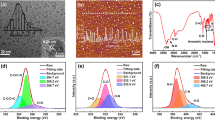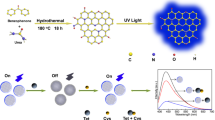Abstract
A simple, sensitive, and selective fluorometric method based on graphene quantum dots and Hg2+ is presented for the determination of tetracycline. The fluorescence emission of graphene quantum dots at 463 nm decreased in the presence of Hg2+ ions due to its electrostatic interaction with the negatively charged surface of quantum dots at pH = 8.0. The addition of tetracycline to this system resulted in the retrieval of the fluorescence emission of the graphene quantum dots proportional to the tetracycline concentration. This is because of the interaction between tetracycline and Hg2+ that results in the release of the quantum dots' surface. Under the optimized conditions, the calibration curve indicated good linearity in the range of 2.0–44.0 nmol L−1 with a detection limit of 0.52 nmol L−1 for tetracycline. The designed nanoprobe was capable of the determination of tetracycline in serum and urine samples.






Similar content being viewed by others
Data Availability
The datasets generated during and/or analyzed during the current study are not publicly available but are available from the corresponding author on reasonable request.”
References
Cháfer-Pericás C, Maquieira A, Puchades R (2010) Fast screening methods to detect antibiotic residues in food samples. Trends Anal Chem 29:1038–1049
Ng K, Linder SW (2003) HPLC separation of tetracycline analogues: comparison study of laser-based polarimetric detection with UV detection. J Chromatogr Sci 41:460–466
Ibarra IS, Rodriguez JA, Miranda JM, Vega M, Barrado E (2011) Magnetic solid phase extraction based on phenyl silica adsorbent for the determination of tetracyclines in milk samples by capillary electrophoresis. J Chromatogr A 1218:2196–2202
Lau C, Lu JZ, Kai M (2004) Chemiluminescence determination of tetracycline based on radical production in a basic acetonitrile-hydrogen peroxide reaction. Anal Chim Acta 503:235–239
Yang X, Luo Y, Zhu S, Feng Y, Zhuo Y, Dou Y (2014) One-pot synthesis of high fluorescent carbon nanoparticles and their applications as probes for detection of tetracyclines. Biosen Bioelectron 56:6–11
Qu F, Sun Z, Liu D, Zhao X, You J (2016) Direct and indirect fluorescent detection of tetracyclines using dually emitting carbon dots. Microchim Acta 183:2547–2553
Shi W, Guo F, Han M, Yuan S, Guan W, Li H, Huang H, Liu Y, Kang Z (2017) N, S co-doped carbon dots as a stable bio-imaging probe for detection of intracellular temperature and tetracycline. J Mater Chem B 18:3293–3299
Tan H, Chen Y (2012) Silver nanoparticle enhanced fluorescence of europium (III) for detection of tetracycline in milk. Sens Actuators B Chem 173:262–267
Liu ML, Chen BB, Yang T, Wang J, Liu XD, Huang CZ (2017) One-pot carbonization synthesis of europium-doped carbon quantum dots for highly selective detection of tetracycline. Methods Appl Fluoresc 5:015003
Li W, Zhu J, Xie G, Ren Y, Zheng YQ (2018) Ratiometric system based on graphene quantum dots and Eu3+ for selective detection of tetracyclines. Anal Chim Acta 1022:131–137
Ma X, Du C, Zhang J, Shang M, Song W (2019) A system composed of vanadium (IV) disulfide quantum dots and molybdenum (IV) disulfide nanosheets for use in an aptamer-based fluorometric tetracycline assay. Microchim Acta 186:1–7
Xing X, Huang L, Zhao S, Xiao J, Lan M (2020) S, N-Doped carbon dots for tetracyclines sensing with a fluorometric spectral response. Microchem J 157:105065
Li Z, Wang Y, Ni Y, Kokot S (2015) A rapid and label-free dual detection of Hg (II) and cysteine with the use of fluorescence switching of graphene quantum dots. Sens Actuators B Chem 207:490–497
Ju J, Chen W (2014) Synthesis of highly fluorescent nitrogen-doped graphene quantum dots for sensitive, label-free detection of Fe (III) in aqueous media. Biosens Bioelectron 58:219–225
Lin L, Rong M, Luo F, Chen D, Wang Y, Chen X (2014) Luminescent graphene quantum dots as new fluorescent materials for environmental and biological applications. TrAC Trends Anal Chem 54:83–102
Yan X, Li B, Li LS (2012) Colloidal graphene quantum dots with well-defined structures. Acc Chem Res 46:2254–2262
Li L, Wu G, Yang G, Peng J, Zhao J, Zhu JJ (2013) Focusing on luminescent graphene quantum dots: current status and future perspectives. Nanoscale 5:4015–4039
Zhang Z, Zhang J, Chen N, Qu L (2012) Graphene quantum dots: an emerging material for energy-related applications and beyond. Energy Environ Sci 5:8869–8890
Kaviani R, Ghaffary S, Jouyban A, Shayanfar A (2020) Developing an analytical method based on graphene quantum dots for quantification of deferiprone in plasma. J Fluoresc 30:591–600
Afsharipour R, Haji Shabani AM, Dadfarnia S, Kazemi E (2020) Selective fluorometric determination of sulfadiazine based on the growth of silver nanoparticles on graphene quantum dots. Microchim Acta 187:1–8
Cheng R, Yu C, Zhen Z, Tang S, Ou S (2020) Understanding the selective-sensing mechanism of lysine by fluorescent nanosensors based on graphene quantum dots. Spectrochim Acta Part A 242:118732
Zhu Q, Mao H, Li J, Hua J, Wang J, Yang R, Li Z (2021) A glycine-functionalized graphene quantum dots synthesized by a facile post-modification strategy for a sensitive and selective fluorescence sensor of mercury ions. Spectrochim Acta Part A 247:119090
Moallemi Bahmani M, Haji Shabani AM, Dadfarnia S, Afsharipour R (2022) Selective and sensitive fluorometric determination of piroxicam based on nitrogen-doped graphene quantum dots and gold nanoparticles coated with phenylalanine. J Fluoresc 32:1337–1346
Abdulghani AJ, Jasim HH, Shebeeb Hassan A (2013) Determination of tetracycline in pharmaceutical preparation by molecular and atomic absorption specterscophotometry and high performance liquid chromatography via complex formation with Au (ɪɪɪ) and Hg (ɪɪ) ions in solutions. Int J Anal Chem 305124:1–11
Afsharipour R, Dadfarnia S, Haji Shabani AM, Kazemi E, Pedrini A, Verucchi R (2021) Fabrication of a sensitive colorimetric nanosensor for determination of cysteine in human serum and urine samples based on magnetic-sulfur, nitrogen graphene quantum dots as a selective platform and Au nanoparticles. Talanta 226:122055
Afsharipour R, Haji Shabani AM, Dadfarnia S (2022) A selective off–on fluorescent aptasensor for alpha-fetoprotein determination based on N-carbon quantum dots and oxidized nanocellulose. J Photochem Photobiol A Chem 428:113872
Bano S, Mohd A, Khan AAP, Siddiqi K (2010) Complexation andmechanism of fluorescence quenching of telmisartan with Y (III) and Nd (III). J Chem Eng Data 55:5759–5765
Mamani MC, Reyes FG, Rath S (2009) Multiresidue determination of tetracyclines, sulphonamides and chloramphenicol in bovine milk using HPLC-DAD. Food Chem 117:545–552
Chen JL (2017) Determination of tetracycline using imprinted polymethacrylates along with fluorescent CdTe quantum dots on plastic substrates. Microchim Acta 184:1335–1343
Uriarte D, Domini C, Garrido M (2019) New carbon dots based on glycerol and urea and its application in the determination of tetracycline in urine samples. Talanta 201:143–148
Shen L, Chen J, Li N, He P, Li Z (2014) Rapid colorimetric sensing of tetracycline antibiotics with in situ growth of gold nanoparticles. AnaL Chim Acta 839:83–90
Amjadi M, Manzoori JL, Pakpoor F (2016) Photometric determination of tetracycline based on surface plasmon resonance of silver nanoparticles. J Anal Chem 71:253–258
Cherkashina K, Vakh C, Lebedinets S, Pochivalov A, Moskvin L, Lezov A, Bulatov A (2018) An automated salting-out assisted liquid-liquid microextraction approach using 1-octylamine: On-line separation of tetracycline in urine samples followed by HPLC-UV determination. Talanta 184:122–127
Funding
The authors declare that no funds, grants, or other support were received during the preparation of this manuscript.
Author information
Authors and Affiliations
Contributions
Maryam Moallemi Bahmani: Data curation, Investigation, Original draft preparation, Shayessteh Dadfarnia and Ali Mohammad Haji Shabani: Supervisor, Writing- reviewing and editing, Roya Afsharipour: Original draft preparation, Writing and conceptualization.
Corresponding authors
Ethics declarations
Ethics Approval
This is an observational study. The XYZ Research Ethics Committee has confirmed that no ethical approval is required.
Consent to Participate and Consent to Publish
This study was not involved human.
Competing Interests
The authors declare that are no financial and personal relationships with other people or organizations that can inappropriately influence our work, there is no professional or other personal interest of any nature or kind in any product, service, and/or company.
Additional information
Publisher's Note
Springer Nature remains neutral with regard to jurisdictional claims in published maps and institutional affiliations.
Supplementary Information
Below is the link to the electronic supplementary material.
Rights and permissions
Springer Nature or its licensor (e.g. a society or other partner) holds exclusive rights to this article under a publishing agreement with the author(s) or other rightsholder(s); author self-archiving of the accepted manuscript version of this article is solely governed by the terms of such publishing agreement and applicable law.
About this article
Cite this article
Moallemi Bahmani, M., Haji Shabani, A., Dadfarnia, S. et al. A Selective Fluorescent Nanoprobe Based on Graphene Quantum Dots and Hg2+ for the Determination of Tetracycline in Biological Samples. J Fluoresc 33, 1067–1075 (2023). https://doi.org/10.1007/s10895-022-03118-7
Received:
Accepted:
Published:
Issue Date:
DOI: https://doi.org/10.1007/s10895-022-03118-7




